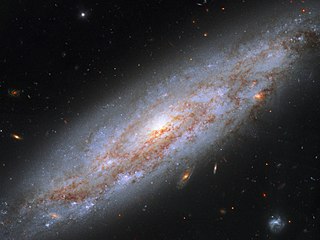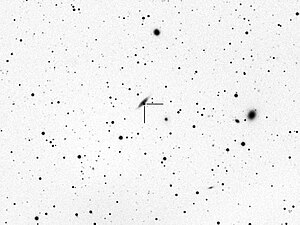
SN 1994D was a Type Ia supernova event in the outskirts of galaxy NGC 4526. It was offset by 9.0″ west and 7.8″ south of the galaxy center and positioned near a prominent dust lane. It was caused by the explosion of a white dwarf star composed of carbon and oxygen. This event was discovered on March 7, 1994 by R. R. Treffers and associates using the automated 30-inch telescope at Leuschner Observatory. It reached peak visual brightness two weeks later on March 22. Modelling of the light curve indicates the explosion would have been visible around March 3-4. A possible detection of helium in the spectrum was made by W. P. S. Meikle and associates in 1996. A mass of 0.014 to 0.03 M☉ in helium would be needed to produce this feature.

NGC 4088 is an intermediate spiral galaxy in the constellation Ursa Major. The galaxy forms a physical pair with NGC 4085, which is located 11′ away.

NGC 1032 is a spiral galaxy that is about 117 million light-years away in the constellation Cetus. It was discovered on 18 December 1783 by German-British astronomer William Herschel.
SN 1999ec was a type Ib supernova that was discovered in the interacting galaxy NGC 2207 on October 2, 1999. It was found on images taken with the Katzman Automatic Imaging Telescope at the Lick Observatory. The progenitor is estimated to have had 38 times the mass of the Sun and was 5.34 million years old at the time of the outburst.
SN 2003H was a supernova that appeared halfway between the colliding NGC 2207 and IC 2163 galaxies. It was discovered on January 8, 2003, by the Lick Observatory and Tenagra Supernova Searches (LOTOSS).
SN 2007uy was a supernova that occurred in the spiral galaxy NGC 2770. It was discovered by Yoji Hirose on December 31, 2007 from Chigasaki city in Japan, approximately four days after the explosion. The position of the supernova was offset 20.6″ east and 15.5″ south of the galaxy's nucleus, near a star-forming region. It was identified as a Type Ib supernova from its spectrum a week before reaching maximum, and appeared the most similar to SN 2004gq.
SN 2005gl was a supernova in the barred-spiral galaxy NGC 266. It was discovered using CCD frames taken October 5, 2005, from the 60 cm automated telescope at the Puckett Observatory in Georgia, US, and reported by Tim Puckett in collaboration with Peter Ceravolo. It was independently identified by Yasuo Sano in Japan. The supernova was located 29.8″ east and 16.7″ north of the galactic core. Based upon its spectrum, this was classified as a Type IIn core-collapse supernova. It has a redshift of z = 0.016, which is the same as the host galaxy.
SN 2005E was a calcium-rich supernova first observed in January 2005 that scientists concluded was a new type of cosmic explosion. The explosion originated in the galaxy NGC 1032, approximately 100 million light years away.
SN 2002bj was the explosion of a star in the galaxy NGC 1821, located in the constellation Lepus. The explosion was discovered by Jack Newton in scans of images produced by Tim Puckett. Initially it had an apparent magnitude of about 14.7 and was categorized as a Type IIn supernova. However, in 2008 Dovi Poznanski discovered that the spectrum more closely resembled a Type Ia supernova. Further, the energy output was much lower than a typical supernova and the luminosity dropped at a dramatic pace.

NGC 4666 is a spiral galaxy in the equatorial constellation of Virgo, located at a distance of approximately 55 megalight-years from the Milky Way. It was discovered by the German-born astronomer William Herschel on February 22, 1784. It is a member of the Virgo II Groups, a series of galaxies and galaxy clusters strung out from the southern edge of the Virgo Supercluster. John L. E. Dreyer described it as "bright, very large, much extended 45°±, pretty suddenly brighter middle". It is a member of an interacting system with NGC 4668 and a dwarf galaxy, and belongs to a small group that also includes NGC 4632.

NGC 3938 is an unbarred spiral galaxy in the Ursa Major constellation. It was discovered on 6 February 1788 by William Herschel. It is one of the brightest spiral galaxies in the Ursa Major South galaxy group and is roughly 67,000 light years in diameter. It is approximately 43 million light years away from Earth. NGC 3938 is classified as type Sc under the Hubble sequence, a loosely wound spiral galaxy with a smaller and dimmer bulge. The spiral arms of the galaxy contain many areas of ionized atomic hydrogen gas, more so towards the center.
SN 1972E was a supernova in the galaxy NGC 5253 that was discovered 13 May 1972 with an apparent B magnitude of about 8.5, shortly after it had reached its maximum brightness. In terms of apparent brightness, it was the second-brightest supernova of any kind of the 20th century. It was observed for nearly 700 days, and it became the prototype object for the development of theoretical understanding of Type Ia supernovae.

SN 1895B was a supernova event in the irregular dwarf galaxy NGC 5253, positioned 16″ east and 23″ north of the galactic center. It is among the closest known extragalactic supernova events. The supernova was discovered by Williamina Fleming on December 12, 1895 after noticing an unusual spectrum on a photographic plate taken July 18, 1895, and was initially given the variable star designation Z Centauri. The light curve is consistent with an event that began ~15 days before the discovery plate was taken, and this indicates the supernova reached a peak visual magnitude of up to 8.49±0.03.

NGC 4790 is a barred spiral galaxy located in the constellation of Virgo. It was discovered on 25 March 1786 by William Herschel and included in the New General Catalogue in 1888. It is a member of the NGC 4699 Group of galaxies, which is a member of the Virgo II Groups, a series of galaxies and galaxy clusters strung out from the southern edge of the Virgo Supercluster.

NGC 6925 is an unbarred spiral galaxy in the constellation Microscopium of apparent magnitude 11.3. It is lens-shaped, as it lies almost edge on to observers on Earth. It lies 3.7 degrees west-northwest of Alpha Microscopii.
SN 2013fs is a supernova, located in the spiral galaxy NGC 7610, discovered by the Intermediate Palomar Transient Factory sky survey at Palomar Observatory in October 2013. It was discovered approximately three hours from explosion and was observed in ultraviolet and X-ray wavelengths, among others, within several hours. Optical spectra were obtained beginning at six hours from explosion, making these the earliest such detailed observations ever made of a supernova.
SN 2013ej is a Type II-P supernova in the nearby spiral galaxy Messier 74. It was discovered by the Lick Observatory Supernova Search on July 25, 2013, with the 0.76 m Katzman Automatic Imaging Telescope, with pre-discovery images having been taken the day before.

NGC 523, also known as Arp 158, from the ARP catalog is a spiral galaxy located in the constellation Andromeda. It was discovered separately by William Herschel on 13 September 1784, and by Heinrich d'Arrest on 13 August 1862. d'Arrest's discovery was listed as NGC 523, while Herschel's was listed as NGC 537; the two are one and the same. John Dreyer noted in the New General Catalogue that NGC 523 is a double nebula.

NGC 3972 is a spiral galaxy located in the northern constellation of Ursa Major. It was discovered by William Herschel on April 14, 1789. This galaxy is located 66 million light years away and is receding with a heliocentric radial velocity of 846 km/s. It is a member of the NGC 3992 Group of galaxies.













